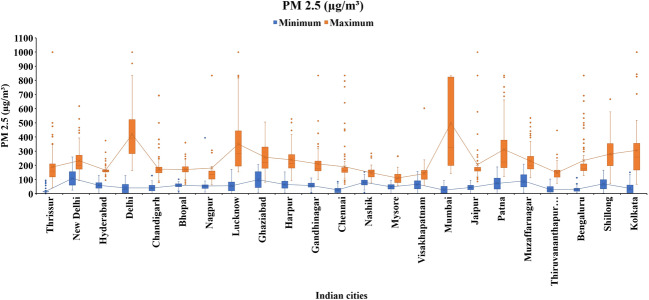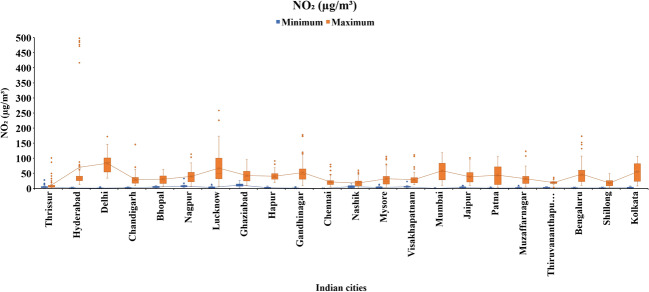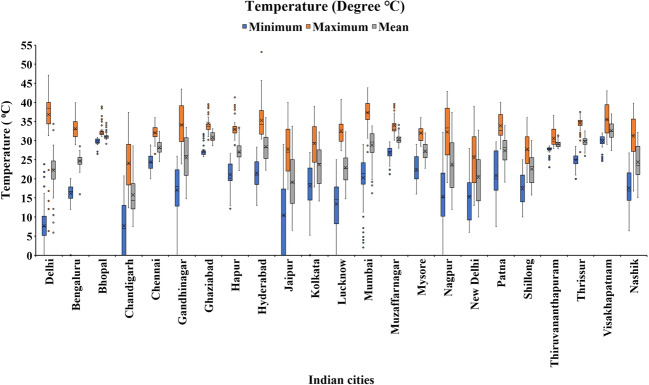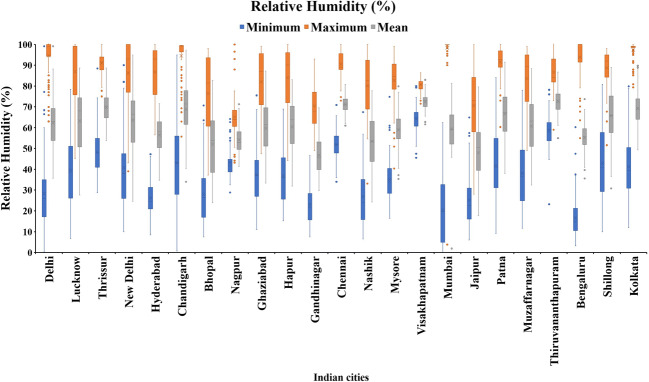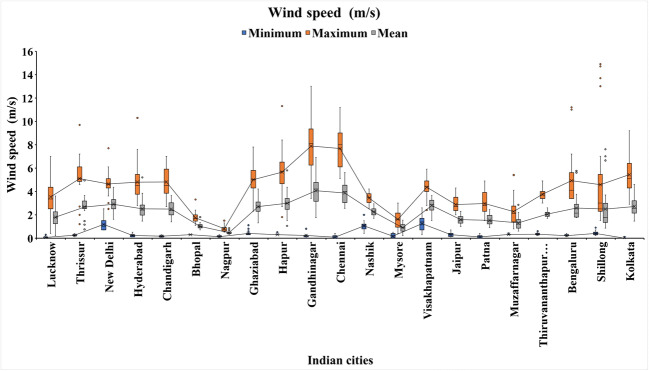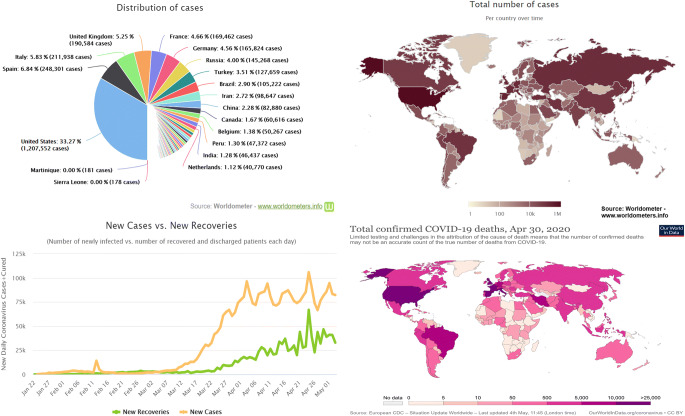Abstract
This research was carried out using the open-source database system along with the continuous air quality monitoring station results from global data sets during the COVID-19 pandemic lockdown in India and the global. Our purpose of this research is to study the improvement of air quality and human mortality rates in countries worldwide during the COVID-19 pandemic lockdown. Worldwide air quality data were collected from > 12,000 continuous air quality monitoring stations on six continents covering 1000 major cities from over 100 countries. Here, we discussed the implementation of the open-source data set of basic air pollutants such as PM 2.5, NO2, temperature, relative humidity, and Air Quality Index variation during the pre-lockdown and lockdown pandemic COVID-19 in India and described the global aspect. An average concentration of PM 2.5 (145.51 μg/m3), NO2 (21.64 μg/m3), and AQI index (55.58) continuously decreased. The variation of PM 2.5, NO2, normally shows more than 25 μg/m3 every year, but during the COVID-19 lockdown period (April 2020) continuously decreased below 20 μg/m3. Similarly, the AQI index and meteorological factors such as temperature, relative humidity, and wind speed variation decreased significantly in the many countries in the world. In Asian countries, air quality improved during the national lockdown especially in the most polluted cities globally such as Beijing, Delhi, and Nanjing and also in developed cities like Madrid, New York, Paris, Seoul, Sydney, Tokyo. Furthermore, the reduction of particulate matter was in about 46%, and other gaseous pollutants during the lockdown period were observed in a 54% reduction. We are witnessing pollution reductions which add significantly to improvements in air quality. This is due to the massive decrease in the use of fossil fuel, which in turn reduces production and traffic in general. People nowadays are now willing to see a comparatively healthier world with bleached skies and natural ecosystems. This research finding demonstrates potential safety benefits associated with improving air quality and mortality rates during the COVID-19 pandemic, resulting in decreases in mortality rates in India and around the world.
Electronic supplementary material
The online version of this article (10.1007/s11869-020-00892-w) contains supplementary material, which is available to authorized users.
Keywords: World Air Quality Index, Air quality improvement, National lockdown, Mortality rate, COVID-19 pandemic
Introduction
The 2019 novel coronavirus disease (COVID-19) epidemic has affected much more huge numbers of vulnerable patients and countable deaths. The rate of infection and deaths are still rising rapidly. COVID-19 seems to be a severe threat to humanity, development, livelihood, the organization of society, and foreign diplomacy. The COVID-19 pandemic is an incredibly rapid dispersal, a world global epidemic. In December 2019, an unidentified virus, officially known as COVID-19, has been recognized in Wuhan China (Zhu et al. 2020). Within 3 months, more than a hundred countries had infected the virus (WHO 2020a, b). The outbreak in COVID-19 infections around the world has turned it into a worldwide pandemic, with catastrophic effects (Wang et al. 2020; Bherwani et al. 2020). There have been over 1.3 million reported cases in 31 cities in the USA, and nearly 80,000 fatalities. Those certain terrible impacted countries such as Spain (219,329 cases with 25,613 deaths), Italy (213,013 cases with 25,315 deaths), and the UK (1, 94,994 cases with 29,427 deaths) also confirmed significant losses (Our World in Data 2020, https://ourworldindata.org/coronavirus; Gayathri 2020).
Air pollution caused by enhanced levels of particulate issue, particularly during a constrained time frame (event), substantially affects neighbourhood atmospheric chemistry and that at long last would prompt influence human health. Transport to an allowable level to maintain air quality at a strategic distance from the hazardous effects of air contamination on nearby residents (Kerimray et al. 2020; Selvam et al. 2020; Singh 2020). Every year the anthropogenic pollutants contribute to unhealthy air quality levels in India (WHO 2020a, b). The World Health Organization (WHO) declared in January 2020 the COVID-19 corona-virus transmission confirmed to the human through respiratory droplets (WHO 2020a, b). Several observation stations and media reported the ground-based observations of air pollution decreased during the national lockdown period all over the world (Mahato et al. 2020; Bagayaraj et al. 2020; Gautam 2020). The national lockdown started on 22 March 2020 (Janta Curfew) in India, the world’s second most populated country, and to the extent 3 weeks national lockdown was started on 24 March 2020 to still date (Chandrashekhar 2020). On 22 March 2020, the Indian Government made a strict lockdown of 1.3 billion citizens under stay at home to reduce the spread of the COVID-19 (Corona-virus) (The Hindu. 2020) and TWC India Edit Team (2020).
The country was full lockdown with no commercial and industrial activity and also reduced the car, bus, truck, and airplane traffic movement. We are witnessing reductions in pollution which add greatly to climate change (Nakada and Custodio 2020). The primary assessment of continuous ambient air quality monitoring data by the CPCB (Central Pollution Control Board) was made available across the nation. Recently, a study on the air quality effects of ‘Janata Curfew’ was published by the CPCB and found that the decrease in the amount of on-road cars contributed to a decreased of up to 51% in nitrogen oxide levels (NOx) and a 32% decrease in carbon dioxide (CO2) levels between 22 and 23 March 2020 compared with 21 March (Singh and Chakraborty (2020). This is due to a dramatic reduction in the use of fossil fuels, which usually decreases the production of manufacturing and traffic (He et al. 2020). People are nowadays able to see a comparatively healthier world with an impact on natural ecosystems. However, this is natural, and the climate would not be helpful in the longer term. People around the world are facing serious challenges from the economic recession, although the percentage of citizens who can manage to operate from home is not immense (Venter et al. 2020; Fareed et al. 2020; UNEP 2019; Cadotte 2020; UNEP Nairobi, Kenya Vishnoi A 2020). Investigators have also found that we do not anticipate the reduction of CO2 concentrations in the environment as a result of this global shutdown (Anjum 2020). NOx is a poisonous gaseous substance that can induce respiratory illnesses and sicken or destroy people as PM 2.5–airborne particles assume the shape 30 times finer than human hair reaching the lungs (Guo et al. 2017; GBD (2017) Risk Factor Collaborators 2018; Achakulwisut et al. 2019; Farrow et al. 2020). NOx is a significant contributor to the formation of the secondary pollutants of particulate matter and ground-level ozone, which also have adverse health effects and are also responsible for smog and acidic rains (Sharma et al. 2020; Gautam 2020).
Many researchers and media discussed satellite-based continuously monitors air pollution measured by the European Space Agency’s (ESA) Sentinel 5P satellite on the Earth and associates with the numbers of COVID-19 deaths worldwide (Myllyvirta and Dahiya 2020; Fareed 2020; Anser 2020; Agarwal et al. 2020). Since the COVID-19 crisis has finished, policymakers will negotiate with air emissions even more efficiently than shut down significant areas of the economy, such as enforcing pollution limits for major polluters (Henriques 2020). However, this process has rendered citizens more mindful of the need to use smooth transport fuels after human operation returns to follow environment-friendly lifestyles. Decreased environmental emissions in the nation and the world are temporary simply because policies are being locked up to varying degrees, and the drastic steps taken to close the market are not feasible as a way to clean up the environment (Dutheil et al. 2020). In the present work, we discuss air quality improvement and estimation of India and global air quality amidst the lockdown period. Generally, the effects and implications of the lockdown are also not fully known and are expected to have a major part to play in improving air quality. The worldwide lockdown amid the COVID-19 pandemic provides a unique opportunity to work in this direction. Consequently, the quantitative evaluation of air pollution needs to be carried out to understand the impact of the air quality lockdown steps, especially where these alternative control measures are needed. The present study is an effort in this straight line to assess the usefulness of the lockdown as an alternative strategy to reduce air pollution at the global level.
The purpose of this research is to study the reduction of air quality and the rate of human mortality in countries around the world during the COVID-19 pandemic before lockdown and after a lockdown. Hence, we assess the open-source data set on air quality, PM 2.5, NO2 levels, Air Quality Index, meteorological variation, and population mortality rate during the COVID-19 pandemic before lockdown and during lockdown variation in India and global perspective.
Materials and methods
The worldwide air quality data collected from > 12,000 continuous ambient air quality monitoring stations and cover 1000 major cities from more than 100 countries in six continents (https://aqicn.org/). The open-source data sets from 30 December 2019 to 28 April 2020 and the hourly intervals were compared during the COVID-19 pandemic before lockdown and during the lockdown. This data set was collected from the World Air Quality Index portal (WAQI) (www.aqicn.org) and region data sets from continuous ambient air quality monitoring data by the Central Pollution Control Board-CAAQMS stations in India (Fig. S1). Therefore, to study more, a total of 138 stations in Asian countries are profoundly affected by the anthropogenic emissions and air quality improvement and environmental benefits as a result of the COVID-19 pandemic lockdown. Generally, we selected basic air pollutants such as PM 2.5 (μg/m3), NO2 (μg/m3), and meteorological data sets (temperature (°C), wind speed (m/s), relative humidity (%), and Air Quality Index (AQI) variation). During the lockdown periods, there are very limited vehicle movements, no flights, no industrial and commercial activities except for essential services, air quality improvement, and environmental benefits (Environmental Protection Agencies 2014). The historical data sets were obtained from 2017 to 2020 in PM 2.5 and NO2 data sets of the Central Pollution Control Board (CPCB). Further, we examined the diurnal variation of air pollutants compared with the worldwide data sets and COVID-19 cases and mortality rate of global data sets collected from the Worldometer data source and discussed the change of death rates. These data sets covered the countries of Mexico, India, Iran, China, France, Chile, El Salvador, USA, South Africa, Viet Nam, Myanmar, Serbia, Russian Federation, Thailand, Indonesia, Guatemala, South Korea, Mali, Bosnia and Herzegovina, Netherlands, Palestine, Mongolia, Bangladesh, Slovakia, Israel, Turkey, Uganda, Uzbekistan, Taiwan, Pakistan, Ecuador, Australia, Austria, Guinea, Japan, Colombia, Belgium, Germany, Macedonia, Hungary, Italy, Hong Kong, United Arab Emirates, Peru, Poland, Czechia, Bolivia, Saudi Arabia, Brazil, Nepal, Macao, Cotedivoire, Iraq, Ethiopia, Spain, Luxembourg, Greece, Norway, Kazakhstan, Canada, Ukraine, New Zealand, Tajikistan, Portugal, United Kingdom, Kosovo, Ireland, Philippines, Kuwait, Finland, Malaysia, Cyprus, Algeria, Croatia, Afghanistan, Romania, Montenegro, San Marino, Lithuania, Bulgaria, Sri Lanka, Armenia, Moldova, Sweden, Ghana, Slovenia, Malta, Denmark, Jordan, Holy See, Andorra, Switzerland, Estonia, Liechtenstein, Kyrgyzstan, Réunion, French Guiana, Argentina, Singapore, Costa Rica, Trinidad and Tobago, Guadeloupe, Curaçao, Martinique, New Caledonia, Iceland, Brunei Darussalam, and Monaco. We used daily concentrations of air pollutants collected from multiple WAQI stations from the Real-time Air Quality Index (WAQI project at https://aqicn.org). The data analysis was undertaken on the large data set to infer the source provenance of the pollutants using Micro Soft Excel 2016.Air pollutant data were undertaken using GeoDa software, the most common multivariate analysis method. The present study area and spatial distribution maps were created with ArcGIS 10.3 and Google Earth Pro version 7.3 software.
Results and discussions
The regional air quality investigated at the 23 major cities in India covered major megacities and rural and suburban zones. The real-time data sets were collected from 30 December 2019 to 28 April 2020 and also were compared with historical data sets from the Central Pollution Control Board in India. The plots of box and whisker that illustrate the top and bottom of each box represent 75th percentile and 25th percentile, respectively, and the upper and lower whiskers display 90th percentile and 10th percentile. The horizontal bar in each box represents the median, and the daily minimum and maximum concentration of PM 2.5 is shown in Fig. 1. An average PM 2.5 concentration (145 μg/m3) decreases during the lockdown period in India. Maximum concentration around 824 (μg/m3) was observed in Mumbai and Delhi region, and minimum values 20 (μg/m3) were observed in the Thrissur region. The PM 2.5 variation normally shows more than 25 μg/m3 per year, but during the COVID-19 lockdown period in April 2020, it continuously decreased below 20 μg/m3 and is shown in Fig. 2. As a result, the fine particle pollutant observed was an improvement at the COVID-19 pandemic of the national lockdown period. The highly polluted cities (Delhi, Mumbai, Lucknow, and Kolkata) in India now sharp decline because of no anthropogenic activities and the major source of emissions stopped at the lockdown periods. Due to the onset of summers, the temperature has started to increase with a minimum and maximum temperature of 12.6 °C and 27 °C on 16 March 2020 to 24 °C and 40 °C on 15 April 2020, leading to dry and dusty conditions. Moreover, it was reported that a mild dust storm from the western part of the country and the gulf regions hit Delhi on 14–15th April, thus rapidly increasing the PM 2.5 levels in Delhi (CPCB report 2020). As reported in the source apportionment study conducted by CPCB 2019, during summers, dust and construction activities (35%), transport sector (20%), and industry (20%) are major sources of particulate matter in Delhi. Compared with normal days, the on-road vehicles were fairly scarce so input from the road dust re-suspension and transport sector was significantly reduced.
Fig. 1.
PM 2.5 level in South Asia (COVID-19 pandemic before and during lockdown)
Fig. 2.
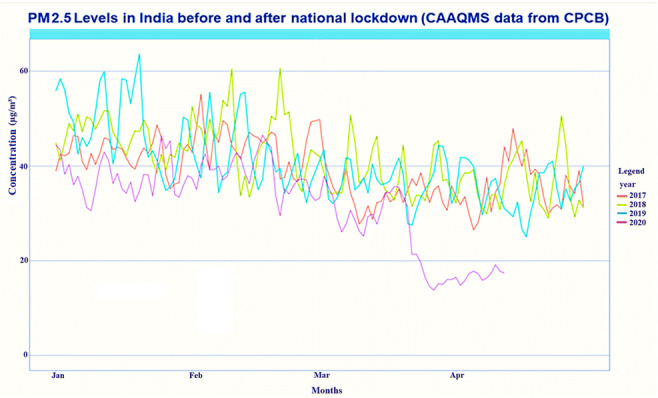
Annual average pollution levels of PM 2.5 in India
The concentration of nitrogen dioxide (NO2) in the COVID-19 pandemic (30 December 2019 to 28 April 2020) before lockdown and after lockdown as well as time series of the daily average and yearly pollution levels is shown in Fig. 3. The box and whisker plots represent the NO2 concentration during COVID-19 pandemic periods in India; the pollution level of maximum (100.45 μg/m3) and minimum (4.6 μg/m3) concentration decreases in Lucknow and Thrissur. NO2 is a poisonous gaseous substance that can induce respiratory illnesses and sicken or destroy people as PM 2.5 airborne particles assume the shape 30 times finer than human hair reaching the lungs (Guo et al. 2017). The NO2 concentration was decreased by 55% during the lockdown period. There are an estimated 350,000 new childhood asthma cases and 16,000 premature deaths annually triggered by NO2, a harmful pollutant in India (Farrow et al. 2020). Due to lockdown policies to varying degrees, the decrease in environmental emissions at the national and global levels is transient, and the drastic steps taken to close the market are not feasible as a way to clean up the environment (Wang et al. 2020). Time-tested approaches are in place to achieve a healthier air quality without barriers to prevent rebounding emission rates as economies turn a corner and corona-virus crisis passes. During the COVID-19 pandemic, air pollution may be increased; people are more vulnerable to this disease (TWC India Edit Team 2020). NO2 emission is a major source of anthropogenic activities and fine particles, but this national lockdown to reduce those anthropogenic activities during the COVID-19 pandemic. The worldwide 4.6 million people died due to poor air quality (Muhammad et al. 2020).
Fig. 3.
NO2 level in India (COVID-19 pandemic before and during lockdown)
The average NO2 result in South India decreased by > 20 μg/m3 from 20 March to 28 April, as shown in Fig. 4. Combustion of coal converts the nitrogen bound in coal to form products such as nitric oxide (NO), nitrogen dioxide (NO2), and nitrous oxide (N2O). These products are collectively called oxides of nitrogen (NOx), a major pollutant. In general, 90–95% of NOx emitted from coal power plants are in the form of NO. NO2 dramatically decrease across South Asia during the quarantine period of COVID-19 pandemic. Last year in India, their pollution has been correlated with 83,000 deaths. Results indicate that the COVID-19 outbreak controlled air quality improvements and substantial human health benefits. During the lockdown period the air quality has increasing trend COVID-19 cause-specific mortality (Sharma et al. 2020). Nitrogen dioxide is an extremely reactive pollutant and a major source of traffic and fossil fuel combustion (He et al. 2020a, b). It may be a source of biomass burning for household cooking and open agricultural burning across the region.
Fig. 4.
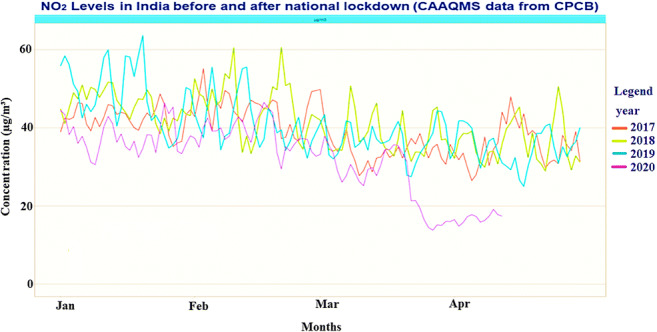
Annual average pollution level of NO2 in India
The meteorological factors such as temperature, relative humidity, and wind speed variation during COVID-19 pandemic before and during lockdown in major cities in South Asia are shown in Figs. 5, 6, and 7. The regional changes of meteorological data sets were collected from 30 December 2019 to 28 April 2020 at the Central Pollution Control Board in India, and the concentration of minimum, maximum, and mean of meteorological factors are shown in the box and whisker plots in Fig. 4. Mean concentration of temperature ranges from 22 to 34 °C, the relative humidity ranges from 60 to 70%, and an average wind speed ranges between 1.5 and 3.8 m/s across the major cities in South Asia. Wind speed was higher during the lockdown period (3.8 m/s) as compared with the pre lockdown period (2.9 m/s). However, with an increase in temperature due to the onset of summers, with high wind speed, there is an increased possibility of the localized lifting of dust, thereby negatively affecting air quality. Ma et al. (2020) explained that the temperature variation and humidity could be one of the factors for the COVID-19 pandemic, and it is positive effects of diurnal temperature ranges. Significantly negative correlations were found between ambient temperature and relative humidity on the diurnal mortality of Corona-virus disease. Liu et al. (2020) indicate that those meteorological factors play a major role in the COVOD-19 transmissions. The weather conditions like low temperature, diurnal temperature ranges, and low relative humidity favour the COVID-19 pandemic transmission. In India, COVID-19 pandemic lockdown mitigates anthropogenic emissions and controlling the multiple air pollutants.
Fig. 5.
The box and whisker plots of temperature variation in India (before and during lockdown COVID-19)
Fig. 6.
The box and whisker plots of relative humidity variation in India (before and during lockdown COVID-19)
Fig. 7.
The box and whisker plots wind speed variation in India (before and during lockdown COVID-19)
Air quality variation before and during lockdown during COVID-19 in India and global perspective
Particulate concentrations (PM 2.5) data sets were collected from 29 February 2020 to 28 April 2020 in South Asia and other countries (Data source: Berkeley Earth). The spatial variation of PM 2.5 concentration is shown in Fig. S2. The maximum concentration (around 400 μg/m3) decreases in major cities of Delhi, Mumbai, Gujarat, and Kolkata in India and other countries (Europe and Central Asia, East Asia and Pacific, America, and Africa). The mean range of PM 2.5 concentration is from 120 to 160 μg/m3. The minimum concentration of PM 2.5 present in East Asia and the UK region with a mean range is from 10 to 30 μg/m3 (Fig. 5). The US AQI is among the most widely recognized index for communicating air quality (EPA 2018). The index converts pollutant concentrations into a colour-coded scale of 0–500, where higher values indicate increased health risk (Helen 2020; WAQI). The US AQI ‘Good’ range (< 12 μg/m3) is marginally higher than the WHO Air Quality Guideline (< 10 μg/m3), as shown in Fig. 5. Particulate concentrations (PM 2.5) before lockdown (29 February 2020) in many countries indicate unhealthy sensitive groups of AQI with the range from 35.5 to 55.4 μg/m3. But during COVID-19 national lockdown (28 April 2020), many countries’ AQI is reduced and under the moderate to good categories of AQI with a mean range of less than 35.4 μg/m3 in across the world. During the Corona-virus disease (COVID-19) time the PM 2.5 data sets were collected from totally 108 countries and 61,178 stations at a diurnal interval of the 30 December 2019 to 28 April 2020 with the overall average minimum, maximum, and median ranges in 27.37, 113.67, and 58.57 (μg/m3) respectively (Fig. S3). Before the national lockdown, the highest annual average of PM 2.5 concentration suffers from South Asia, Southeast Asia, and East Asia countries and regions because of the weighted by population. In India, Delhi is the highest in the AQI ranking, with its annual concentration of PM 2.5 being higher in the WHO target. During the national lockdown from the global perspective, the PM 2.5 concentrations (12.1 to 35.4 μg/m3) in moderate AQI levels all around the Asian countries are shown in Fig. 5. The PM 2.5 concentration to consistent improvement in the USA is similar to the maximum concentration in the East Asia countries, specifically Hotan, China Mainland (Fig. 6). Clean Air Coalition 2019, reported that global premature deaths in 35% occurred in East Asia regions, followed closely by 33% that occurs in South Asia. However, during the COVID-19 lockdown period, PM 2.5 concentrations decreased in heavily polluted cities. The primary source of anthropogenic activities was the emissions of air pollutants decreased in the full national lockdown periods. In our results in February 2020, the PM 2.5 concentration increased and decreased in April 2020 because of the national lockdown fully implemented by the last week of March 2020.
The NO2 data sets collected from 59,312 stations between 30 December 2019 and 28 April 2020 with the overall average minimum, maximum, and median ranges are 3.24, 30.24, and 10.14 (μg/m3) respectively. The daily (30 December 2019 to 28 April 2020) NO2 concentrations decreased significantly in the many countries in the world, and the air quality scale indicated less than 12 μg/m3 the ‘Good’ category, as shown in Fig. S4. The NO2 concentration was reduced in some cities in all around the world like Amsterdam, Bangalore, Beijing, Bern, Bogota, Chengdu, Delhi, Lima, Madrid, Nanjing, New York, Oslo, Paris, Rome, San Francisco, Santiago, Sao Paulo, Warsaw, and Wuhan. However, a few cities from China (Chengdu, Nanjing, and Wuhan) and Iraq were in under the ‘Moderate/Satisfactory’ category; the concentration is 12 to 35 μg/m3. As evident from monitored air quality data, the pollutant emissions were reduced by up to 50% and 40% respectively. Under this pandemic lockdown, all kinds of transport services stopped with exceptions for essential services. As a result, air quality improvement has been noted in many cities around the world. The Air Quality Index is generally based on the measurement of the pollutant criteria as an index for the reporting of daily air quality. The US AQI was developed by the EPA and is used to convey whether the air around the environment is clean or polluted (Ott and Thorn 1976). In addition, the specifics of different sub-indices for air pollutants and the cautionary statements for the Air Quality Index (AQI) Guidance were adopted by the EPA 2018 report. The AQI data sets collected from a total of 67,502 stations during the Corona-virus disease (COVID-19) from 30 December 2019 to 28 April 2020 with the overall average minimum, maximum, and median range in 39.31, 71.84, and 52.72 respectively (Fig. S5). In context with worldwide AQI, the concentration has been reported to drop at the end of second week of COVID-19 lockdown. In terms of air quality index, maximum countries fall in the ‘Good’ category, but Asian countries fall under the ‘Moderate/Satisfactory’ category as on 30 December 2019 to 28 April 2020. Based on meteorological data sets collected during the Corona-virus disease (COVID-19) from 30 December 2019 to 28 April 2020, the overall average minimum, maximum, and median ranges in relative humidity are 45%, 88%, and 68% respectively. Similarly, average temperature minimum, maximum, and median ranges are 7, 20, and 11 °C and wind speed 0.8, 8.02, and 3.2 m/s based on the World Air Quality Index as on 30 December 2019 to 28 April 2020 (Fig. 8). All of the major cities and countries the AQI analysed, and its result, indicate mostly within Good–Moderate categories of the lockdown period. During the lockdown period, there has been a general improvement in air quality in the world as a result of the restrictions imposed during the lockdown. Also, the historical data sets were obtained in Central Pollution Control Board PM 2.5 and NO2 data set from 2017 to 2020. In general, air pollution was contributing to the major sector of industries, transport, biomass and refuse burning, power plants, road dust re-suspension, construction, and residential activities. Nonetheless, this lockdown introduced to many air pollutant sources indicates the natural condition for observing the temporary and higher impacts on socio-economic costs of air quality reduction.
Fig. 8.
The distribution of COVID-19 cases, new recoveries, and total confirmed death up to April 2020
Distribution of COVID 19 cases and mortality rate of global
The air pollution improvement during the Corona-virus disease (COVID-19) lockdown periods indicates the population mortality rate, and saving lives propel life across the world. The distribution of active COVID-19 cases shows 33.27% of the world’s estimated impacted populations in the USA (1,207,552 cases in April 2020); the minimum cases in Sierra Leone are less than 1% (178 cases) shown in Fig. 8. The Worldometer COVID-19 data sets was daily updated in the total number of COVID-19 active cases in global and its spatial variations given in Fig. 8. The country wise total number of confirmed cases, deaths reported on April 30, 2020, as shown in Fig. 8, but these data were obtained from the European CDC at updated corona-virus links (Our World at Data.org). The lowest testing rates for coronavirus cases was challenging one in the developing countries attribute mean the number of confirmed deaths may not be an accurate count of the actual number of COVID-19 deaths. Air quality is one of the factors that aggravate the death rate of corona-virus COVID-19 (Wu et al. 2020). The long-term health effects of COVID-19 diseases from air pollution and increased mortality rates. Similarly, the pre-existing health conditions (respiratory and cardiovascular) also increase the risk of death ratio. The clean air may reduce the death rate of COVID-19 during the national lockdown periods. While the air quality improvement and national lockdown actions to mitigate and control the COVID-19 pandemic. Air pollution has also been referred to as a ‘silent global health disaster’, an outbreak that kills seven million people a year, rendering it a more serious danger than any other form of emissions (Wu et al. 2020; Shrestha et al. 2020).
Conclusions
In this study, the impacts of pollution improvements due to reduced anthropogenic intervention in India and Worldwide during the COVID-19 outbreak have been studied. This work was performed using an open-source database system in combination with CAAQMS findings from PM 2.5, NO2 levels, air quality index, meteorological variability, and population mortality rates during COVID-19 pandemic prior to lockdown and during India lockdown and global perspective variability. However, many believe that the Corona-virus spread has reduced air and water pollution and has probably even saved a life in this system. Even now, this epidemic that takes people’s lives should not necessarily be seen as a way to bring about positive change to the environment. Anthropogenic pollution control has also led to improvements in concentrations of PM 2.5, NO2, and AQI as well as meteorological variations, mainly in the transportation and industrial activities. This could be temporary for the environment, but it can be understood by policymakers and by people how to reduce emissions in the long term. From the global perspective, the concentrations of PM 2.5 in moderate AQI rate in the all-around Asian countries during the national lockdown of Corona-virus disease (COVID-19). The concentrations of particulates (PM 2.5) in many countries before lockdown (29 February 2020) indicate the ranges in 35.5 to 55.4 μg/m3 of unhealthy sensitive AQI groups. The significant decrease in NO2 concentration in many countries around the world daily (30 December 2019 to 28 April 2020) and the air quality scale indicated the ‘Good’ category. However, a few cities from China and Iraq were under the ‘Moderate/Satisfactory’ category. But during Corona-virus disease (COVID-19) during national lockdown (28 April 2020) many countries’ AQI is reduced and under the Moderate to Good categories of AQI with a mean range of less than 35.4 μg/m3 across the world. The air quality standards for PM 2.5 to improved in USA similar to the maximum concentration in the East Asian countries, specifically Hotan, China Mainland. In context with worldwide AQI, concentration has been reported to drop at the end of the second week of COVID-19 lockdown. In terms of air quality index in maximum countries fall in the ‘Good’ category but in Asian countries were under the ‘Moderate/Satisfactory’ category as on 30 December 2019 to 28 April 2020. The distribution of active COVID-19 cases indicates in the global that the maximum people affected in the USA is 33.27% (1,207,552 cases in April 2020) and the minimum cases fall in Sierra Leone less than 1% (178 cases). The clean air may reduce the death rate of COVID-19 during the national lockdown periods. It also enhances air quality and takes regional lockdown measures to mitigate and control the COVID-19 pandemic. The distribution of active COVID-19 cases shows that the impacted population in the USA is 33.27% (1,207,552 cases in April 2020) and that the total cases in Sierra Leone dropped below 1% (178 cases). Similarly, the pre-existing health conditions (respiratory and cardiovascular) also increase the risk of death ratio. This result shows potential safety benefits associated with the improvement in air quality and mortality rate during the COVID-19 pandemic, resulting in decreases in the number of deaths in India and worldwide. However, the new COVID-19 pandemic led reduced global air quality and may cause potential respiratory problems worse because the national lockdown becomes eliminated and temporarily stopped industry activities gradually normalized anthropogenic emission.
Electronic supplementary material
(DOCX 2238 kb).
Acknowledgements
Authors would like to thank the Central Pollution Control Board, Ministry of Environment, Forest and Climate Change (MoEFCC), and Ministry of Human Resources and Development, Government of India. We thank the World’s Air Pollution: Real-time Air Quality Index (WAQI project) for providing air quality data sets (https://aqicn.org/) and COVID 19 cases and mortality rate of global obtained from Worldometer data sets (Our World in Data.org).
Footnotes
Publisher’s note
Springer Nature remains neutral with regard to jurisdictional claims in published maps and institutional affiliations.
References
- Achakulwisut P, Brauer M, Hystad P, Anenberg SC. Global, national, and urban burdens of pediatric asthma incidence attributable to ambient NO2 pollution: estimates from global datasets. The Lancet Planet Health. 2019;3(4):e166–e178. doi: 10.1016/S2542-5196(19)30046-4. [DOI] [PubMed] [Google Scholar]
- Agarwal A, Kaushik A, Kumar S, Mishra RK (2020) Comparative study on air quality status in Indian and Chinese cities before and during the COVID-19 lockdown period. Air Qual Atmos Health 13:1167–1178. 10.1007/s11869-020-00881-z [DOI] [PMC free article] [PubMed]
- Naser A Anjum (2020) Good in the worst: COVID-19 restrictions and ease in global air pollution, Preprints (www.preprints.org), Posted: 6 April 2020. 10.20944/preprints202004.0069.v1
- Anser MK (2020) The impacts of COIVD 19 measures on global environment and fertility rate: double coincidence. Air Qual Atmos Health. 10.1007/s11869-020-00865-z [DOI] [PMC free article] [PubMed]
- Bagayaraj M, Shankar K, Mengistie AT, Muthukumarasamy R, Gnanachandrasamy G. Distribution and trend analysis of COVID-19 in India: geospatial approach. J Geographical Studies. 2020;4(1):1–9. doi: 10.21523/gcj5.20040101. [DOI] [Google Scholar]
- Bherwani H, Nair M, Musugu K, Gautam S, Gupta A, Kapley A, Kumar R. Valuation of air pollution externalities: comparative assessment of economic damage and emission reduction under COVID-19 lockdown. Air Qual Atmos Health. 2020;13:683–694. doi: 10.1007/s11869-020-00845-3. [DOI] [PMC free article] [PubMed] [Google Scholar]
- Cadotte M (2020) Early evidence that COVID-19 government policies reduce urban air pollution. 10.31223/osf.io/nhgj3
- Central pollution control board (CPCB) (2020) Ambient air quality data at COVID 19. http://www.cpcb.gov.in/CAAQM/frmUserAvgReportCriteria.aspx
- Chandrashekhar V (2020) 1.3 billion people. A 21-day lockdown. Can India curb the coronavirus? Science. 10.1126/science.abc0030
- Clean Air Coalition (2019) Air pollution measures for Asia and the Pacific. Retrieved February 17, 2020, from https://www.ccacoalition.org/en/content/air-pollution-measures-asia-and-pacific
- Dutheil F, Baker SJ, Navel V. COVID-19 as a factor influencing air pollution? Environ Pollut. 2020;263:114466. doi: 10.1016/j.envpol.2020.114466. [DOI] [PMC free article] [PubMed] [Google Scholar]
- Environmental Protection Agency (2014) Air quality index: a guide to air quality and your health. U.S. Environmental Protection Agency, Office of Air Quality Planning and Standards. https://www3.epa.gov/airnow/aqi_brochure_02_14.pdf
- Fareed Z (2020) Co-variance nexus between COVID-19 mortality, humidity, and air quality index in Wuhan, China: new insights from partial and multiple wavelet coherence. Air Qual Atmos Health. 10.1007/s11869-020-00847-1 [DOI] [PMC free article] [PubMed]
- Fareed Z, Iqbal N, Shahzad F, Shah SGM, Zulfiqar B, Shahzad K, Hashmi SH, Shahzad U. Co-variance nexus between COVID-19 mortality, humidity, and air quality index in Wuhan, China: new insights from partial and multiple wavelet coherence. Air Qual Atmos Health. 2020;13:673–682. doi: 10.1007/s11869-020-00847-1. [DOI] [PMC free article] [PubMed] [Google Scholar]
- Farrow A, Miller KA, Myllyvirta L. Toxic air: the price of fossil fuels. Seoul: Greenpeace Southeast Asia; 2020. p. 44. [Google Scholar]
- Gautam S. COVID-19: air pollution remains low as people stay at home. Air Qual Atmos Health. 2020;13:853–857. doi: 10.1007/s11869-020-00842-6. [DOI] [PMC free article] [PubMed] [Google Scholar]
- Gayathri V. People power: how India is attempting to slow the coronavirus. Nature. 2020;580:442. doi: 10.1038/d41586-020-01058-5. [DOI] [PubMed] [Google Scholar]
- GBD (2017) Risk Factor Collaborators Global, regional, and national comparative risk assessment of 84 behavioural, environmental and occupational, and metabolic risks or clusters of risks for 195 countries and territories, 1990–2017: a systematic analysis for the Global Burden of Disease Study 2017. Lancet. 2018;392(10159):1923. doi: 10.1016/S0140-6736(18)32225-6. [DOI] [PMC free article] [PubMed] [Google Scholar]
- Guo H, Kota SH, Sahu SK, Hu J, Ying Q, Gao A. Source apportionment of PM2.5 in North India using source-oriented air quality models. Environ Pollut. 2017;231:426–436. doi: 10.1016/j.envpol.2017.08.016. [DOI] [PubMed] [Google Scholar]
- He G, Pan Y, Tanaka T (2020) COVID-19, city lockdown, and air pollution: evidence from China. medRxiv. 10.1101/2020.03.29.20046649
- He MZ, Kinney PL, Li T, Chen C, Sun Q, Ban J, Wang J, Liu S, Goldsmith J, Kioumourtzoglou MA. Short- and intermediate-term exposure to NO2 and mortality: a multi-county analysis in China. Environ Pollut. 2020;261:114165. doi: 10.1016/j.envpol.2020.114165. [DOI] [PMC free article] [PubMed] [Google Scholar]
- He L, Zhang S, Hu J, Li Z, Zheng X, Cao Y, Xu G, Yan M, Wu Y. On-road emission measurements of reactive nitrogen compounds from heavy-duty diesel trucks in China. Environ Pollut. 2020;262:114280. doi: 10.1016/j.envpol.2020.114280. [DOI] [PubMed] [Google Scholar]
- Helen A (2020) The ultimate guide to understanding air quality data in 2020. Breez Meter, 2 Jan. 2020, https://blog.breezometer.com/ultimate-guide-understanding-air-quality-data, accessed on 31 March 2020
- Henriques M (2020) Will Covid-19 have a lasting impact on the environment? 27th March 2020, https://www.bbc.com/future/article/20200326-covid-19-the-impact-of-coronavirus-on-theenvironment, accessed on 29 March 2020
- https://www.who.int/docs/default-source/coronaviruse/situation-reports/20200404-sitrep-75-COVID-19.pdf?sfvrsn=99251b2b_2
- Kerimray A, Baimatova N, Ibragimova OP, Bukenov B, Kenessov B, Plotitsyn P, Karaca F. Assessing air quality changes in large cities during COVID-19 lockdowns: the impacts of traffic-free urban conditions in Almaty, Kazakhstan. Sci Total Environ. 2020;730:139179. doi: 10.1016/j.scitotenv.2020.139179. [DOI] [PMC free article] [PubMed] [Google Scholar]
- Liu J, Zhou J, Yao J, Zhang X, Li L, Xu X, He X, Wang B, Shihua F, Niu T, Yan J, Shi Y, Ren X, Niu J, Zhu W, Li S, Luo B, Zhang K. Impact of meteorological factors on the COVID-19 transmission: a multi-city study in China. Sci Total Environ. 2020;726:138513. doi: 10.1016/j.scitotenv.2020.138513. [DOI] [PMC free article] [PubMed] [Google Scholar]
- Ma Y, Zhao Y, He X, Wang B, Fu S, Yan J, Niu J, Zhou J, Luo B. Effect of temperature variation and humidity on the death of COVID-19 in Wuhan, China. Sci Total Environ. 2020;724:138226. doi: 10.1016/j.scitotenv.2020.138226. [DOI] [PMC free article] [PubMed] [Google Scholar]
- Mahato S, Pal S, Ghosh KG. Effect of lockdown amid COVID-19 pandemic on air quality of the megacity Delhi, India. Sci Total Environ. 2020;730:139086. doi: 10.1016/j.scitotenv.2020.139086. [DOI] [PMC free article] [PubMed] [Google Scholar]
- Muhammad S, Long X, Salman M. COVID-19 pandemic and environmental pollution: a blessing in disguise? Sci Total Environ. 2020;728(2020):138820. doi: 10.1016/j.scitotenv.2020.138820. [DOI] [PMC free article] [PubMed] [Google Scholar]
- Myllyvirta L, Dahiya S (2020) Air quality improvements due to COVID 19 lock-down in India: assessment of NO2 satellite data from sentinel 5P-TROPOMI for a period of 11th March – 24th March & 25th March – 7th April for 2019 and 2020. Centre for Research on Energy and Clean Air report in 2020. https://energyandcleanair.org/air-quality-improvements-due-to-covid-19-lock-down-in-india/
- Nakada LYK, Custodio R. COVID-19 pandemic: impacts on the air quality during the partial lockdown in São Paulo state, Brazil. Sci Total Environ. 2020;730:139087. doi: 10.1016/j.scitotenv.2020.139087. [DOI] [PMC free article] [PubMed] [Google Scholar]
- Ott WR, Thorn GC. Air pollution index systems in the United States and Canada. J Air Pollut Control Assoc. 1976;26(5):460–470. doi: 10.1080/00022470.1976.10470272. [DOI] [PubMed] [Google Scholar]
- Selvam S, Muthukumar P, Venkatramanan S, Roy PD, Manikanda Bharath K, Jesuraja K. SARS-CoV-2 pandemic lockdown: effects on air quality in the industrialized Gujarat state of India. Sci Total Environ. 2020;737:140391. doi: 10.1016/j.scitotenv.2020.140391. [DOI] [PMC free article] [PubMed] [Google Scholar]
- Sharma S, Zhang M, Anshika, Gao J, Zhang H, Kota SH. Effect of restricted emissions during COVID-19 on air quality in India. Sci Total Environ. 2020;728:138878. doi: 10.1016/j.scitotenv.2020.138878. [DOI] [PMC free article] [PubMed] [Google Scholar]
- Shrestha AM, Shrestha UB, Sharma R, Bhattarai S, Tran HNT, Rupakheti M (2020) Lockdown caused by COVID-19 pandemic reduces air pollution in cities worldwide. EarthArXiv. 10.31223/osf.io/edt4j
- Singh RP. Impact of lockdown on air quality in India during COVID-19 pandemic, June 2020. Air Qual Atmos Health. 2020;13:921–928. doi: 10.1007/s11869-020-00863-1. [DOI] [PMC free article] [PubMed] [Google Scholar]
- Singh RK, Chakraborty D (2020) Singh world’s dirtiest air gets cleaner after India’s lockdown. https://www.bloomberg.com/news/articles/2020-04-07/world-sdirtiest-air-gets-cleaner-after-india-s-lockdown
- The Hindu (2020) Air quality improves amid lockdown in India, 2 Apr 2020, https://www.thehindu.com/news/national/air-quality-improves-in-india amid lockdown/. article31234638.ece
- The United States Environmental Protection Agency Office of Air Quality Planning and Standards (2018) Technical assistance document for the reporting of daily air quality—the Air Quality Index (AQI), Air Quality Assessment Division Research Triangle Park, NC Publication No EPA -454/B -18 -007 September 2018
- TWC India Edit Team (2020) COVID-19: high pollution, smoking make you more vulnerable to novel coronavirus disease, warn doctors. The Weather Channel India, 8 March 2020. https://weather.com/en-IN/india/pollution/news/2020-03-18-covid-19-pollution-smoking vulnerable-novel-corona virus-disease
- UNEP (2019) Air pollution in Asia and the Pacific: science-based solutions:1-250
- UNEP Nairobi, Kenya Vishnoi A (2020) Lockdown clears up India's air, Economics Times. https://economictimes.indiatimes.com/news/politics-and-nation/lockdown-clears-up-indiasair/articleshow/74942627.cms
- Venter ZS, Aunan K, Chowdhury S, Lelieveled J (2020) COVID-19 lockdowns cause global air pollution declines with implications for public health risk. medRxiv preprint. 10.1101/2020.04.10.20060673
- Wang P, Chen K, Zhu S, Wang P, Zhang Severe air pollution events not avoided by reduced anthropogenic activities during the COVID-19 outbreak. Resour Conserv Recycl. 2020;158:104814. doi: 10.1016/j.resconrec.2020.104814. [DOI] [PMC free article] [PubMed] [Google Scholar]
- WHO (2020a) Air Pollution http://www9.who.int/airpollution/en/
- WHO (2020b) Coronavirus disease 2019 (COVID-19) Situation Report – 75
- Wu X, Nethery RC, Sabath BM, Braun D, Dominici F (2020) Exposure to air pollution and COVID-19 mortality in the United States. medRxiv. 10.1101/2020.04.05.20054502 [DOI] [PMC free article] [PubMed]
- Zhu N, Zhang D, Wang W, Li X, Yang B, Song J et al (2020) A novel coronavirus from patients with pneumonia in China, 2019. N Engl J Med 382:727–733. 10.1056/NEJMoa2001017 [DOI] [PMC free article] [PubMed]
Associated Data
This section collects any data citations, data availability statements, or supplementary materials included in this article.
Supplementary Materials
(DOCX 2238 kb).



